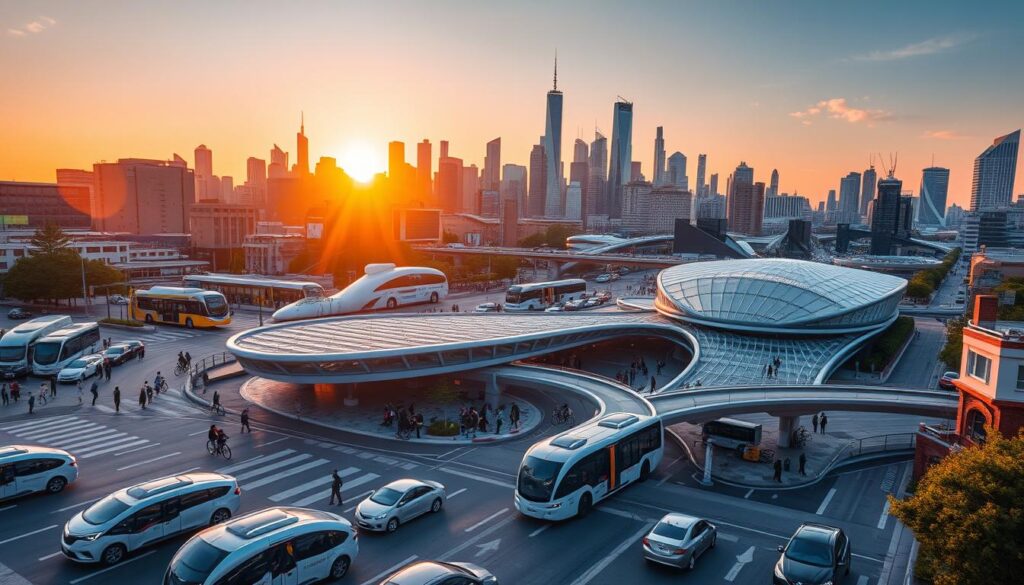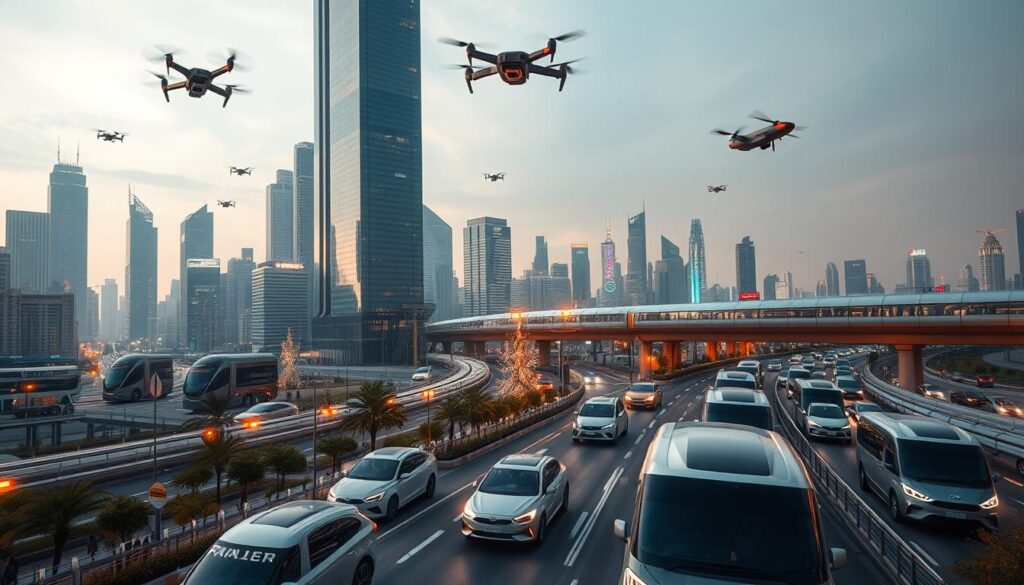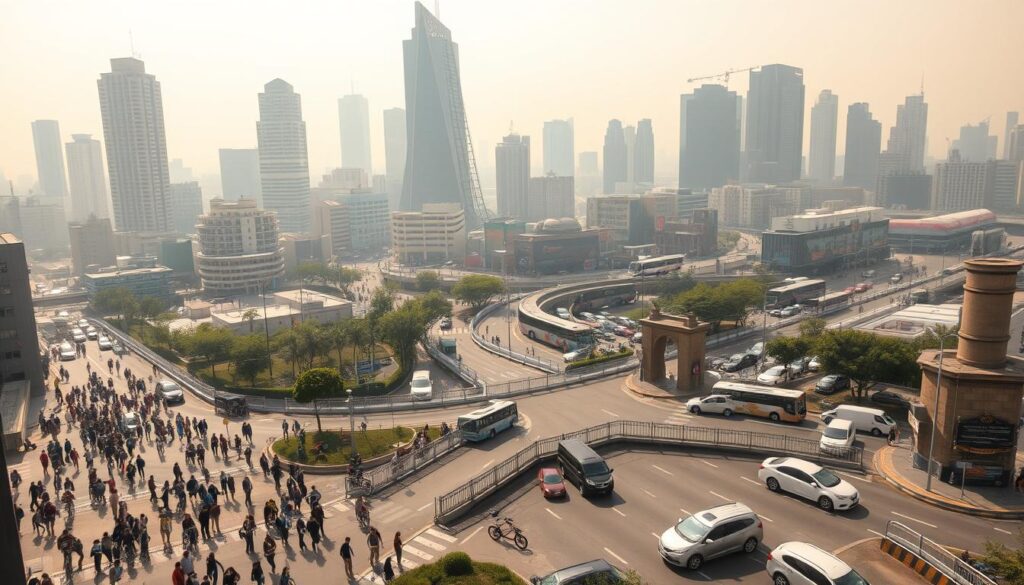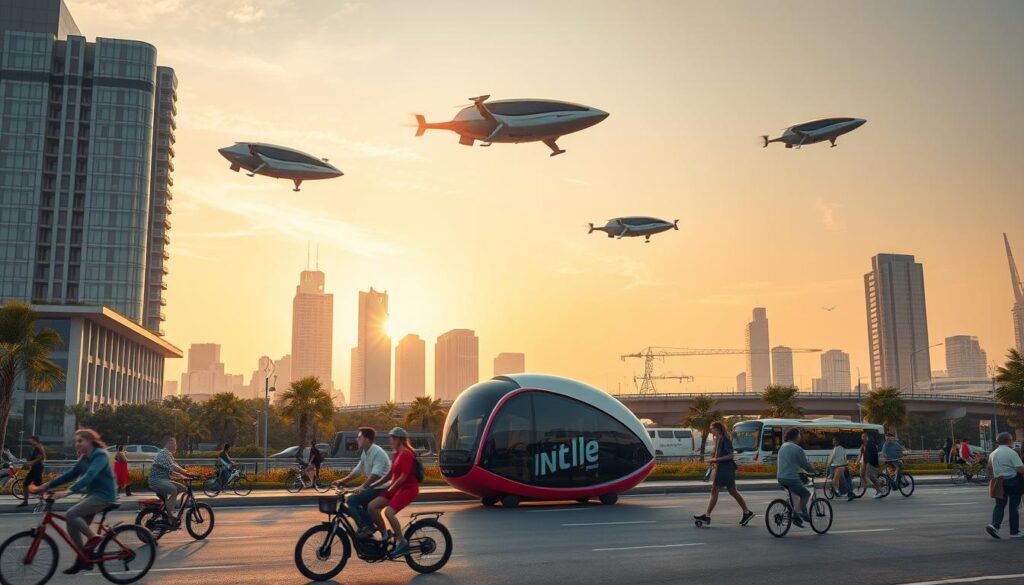Can cities around the world find a way to balance the needs of a growing population with the need for sustainable transportation solutions? As urban areas continue to expand, the importance of effective city transportation strategies becomes increasingly clear.
Urban mobility is a critical aspect of modern cities, affecting not only the quality of life for residents but also economic productivity and environmental sustainability. With the rise of innovative transportation solutions, cities now have the opportunity to rethink their transportation networks and create a more efficient, sustainable future.
Key Takeaways
- Efficient city transportation strategies are crucial for modern cities.
- Sustainable transportation solutions can improve quality of life and economic productivity.
- Urban mobility planning requires careful consideration of environmental sustainability.
- Innovative transportation solutions can help cities rethink their transportation networks.
- Effective transportation planning is key to a city’s future success.
What is Urban Mobility Planning?
The concept of urban mobility planning revolves around creating sustainable and efficient transportation systems within cities. It involves a comprehensive approach to managing the movement of people and goods, aiming to reduce congestion, pollution, and enhance the quality of life for urban residents.
Definition and Concepts
Urban mobility planning is defined as the process of creating and implementing strategies to optimize urban transportation networks. This includes transportation demand management, which focuses on reducing the need for personal vehicles by promoting alternative modes of transport such as public transit, cycling, and walking.
For a detailed understanding of urban mobility, visiting resources like Liftango’s guide on defining urban mobility can provide valuable insights.
- Integrating different transportation modes
- Enhancing public transportation systems
- Promoting non-motorized transport
- Implementing smart traffic management systems
Key Components of Urban Mobility
The key components of urban mobility planning include:
- Infrastructure Development: Building and maintaining roads, public transport systems, and pedestrian and cycling infrastructure.
- Transportation Demand Management: Strategies to reduce personal vehicle usage, such as congestion pricing and low-emission zones.
- Smart Traffic Management: Using technology to optimize traffic flow and reduce congestion.
Effective urban transportation planning requires a collaborative effort among government agencies, private sector entities, and the community to create sustainable and efficient mobility solutions.
The Importance of Urban Mobility Planning
Effective urban mobility planning is the backbone of sustainable urban development. It not only enhances the quality of life for residents but also contributes to a healthier environment. As cities continue to grow, the need for well-planned mobility systems becomes increasingly important.
Enhancing Quality of Life
Urban mobility planning plays a crucial role in improving the daily lives of city dwellers. By investing in public transit systems, cities can reduce traffic congestion, making commutes faster and more efficient. This, in turn, can boost economic productivity and improve overall quality of life.
“The way we move around our cities has a profound impact on our quality of life, from the air we breathe to the time we spend commuting.” – Urban Planning Expert
Furthermore, well-designed mobility plans prioritize pedestrian and cycling infrastructure, promoting a more active and healthy lifestyle among residents. This not only enhances individual well-being but also fosters a sense of community.
Environmental Impact
The environmental benefits of effective urban mobility planning cannot be overstated. By promoting the use of public transit and non-motorized transport, cities can significantly reduce their carbon footprint. This shift towards smart city mobility solutions is crucial in the fight against climate change.
| Mode of Transport | Carbon Emissions | Health Impact |
|---|---|---|
| Private Vehicles | High | Negative |
| Public Transit | Low | Positive |
| Cycling/Walking | Zero | Very Positive |
As shown in the table, shifting towards public transit and non-motorized transport can have a significant positive impact on both the environment and public health.

Current Trends in Urban Mobility
As urban populations grow, cities are adopting innovative urban mobility planning approaches to enhance the quality of life for their residents. The need for efficient, sustainable, and integrated transportation systems has never been more pressing.
Public Transportation Innovation
Cities are revolutionizing public transportation by incorporating advanced technologies and innovative strategies. Smart traffic management systems are being implemented to optimize traffic flow and reduce congestion. For instance, cities like Singapore and London have introduced smart traffic lights that adjust their timing based on real-time traffic conditions.
Moreover, the integration of public transportation with other modes of mobility is becoming increasingly common. Multi-modal transportation hubs are being developed to facilitate seamless transfers between buses, trains, and other forms of transportation, enhancing the overall efficiency of the transportation network.
Micro-Mobility Solutions
The rise of micro-mobility solutions such as e-bikes and e-scooters is transforming the way people move around cities. These solutions offer a convenient, environmentally friendly alternative to traditional modes of transportation for short distances.
Cities are responding by implementing regulations to ensure the safe integration of micro-mobility solutions into the existing transportation infrastructure. For example, designated lanes for e-bikes and e-scooters are being created to reduce conflicts with other road users.
Autonomous Vehicles
Autonomous vehicles are poised to revolutionize urban mobility by enhancing safety, reducing traffic congestion, and improving air quality. Cities are beginning to test autonomous vehicles in controlled environments to assess their feasibility and potential impact.
The integration of autonomous vehicles into public transportation systems could significantly enhance the efficiency and accessibility of urban mobility. However, it also raises important questions about regulation, public acceptance, and infrastructure requirements.
In conclusion, the current trends in urban mobility are characterized by a shift towards more sustainable, efficient, and integrated transportation systems. By embracing city transportation strategies that incorporate innovation and technology, cities can create a better future for their residents.
The Role of Technology in Urban Mobility
As cities continue to grow, technology plays a crucial role in enhancing urban mobility through smart traffic management and data-driven planning. The integration of advanced technologies is transforming the urban transportation landscape, making it more efficient, sustainable, and user-friendly.
Smart Traffic Management Systems
Smart traffic management systems are at the forefront of urban mobility innovation. These systems utilize real-time data and advanced analytics to optimize traffic flow, reduce congestion, and minimize travel times. For instance, smart traffic lights can adjust their timing based on real-time traffic conditions, significantly improving the efficiency of intersections.
The implementation of smart traffic management systems has shown promising results in various cities. For example, cities that have adopted intelligent transportation systems (ITS) have reported reductions in traffic congestion and improvements in air quality. Data analytics plays a pivotal role in these systems, enabling cities to make informed decisions based on traffic patterns and trends.

Data-Driven Planning Tools
Data-driven planning tools are revolutionizing urban transportation planning by providing insights that were previously unattainable. These tools analyze vast amounts of data from various sources, including traffic sensors, public transit systems, and user feedback, to inform planning decisions. By leveraging data analytics, cities can optimize their transportation infrastructure and services to better meet the needs of their residents.
One of the key benefits of data-driven planning is the ability to predict and mitigate potential issues before they become major problems. For instance, by analyzing traffic data, cities can identify areas prone to congestion and implement targeted solutions, such as optimizing traffic signal timing or improving public transit routes.
- Enhanced traffic flow through real-time monitoring
- Improved public transit efficiency through data analysis
- Better urban planning decisions through data-driven insights
By embracing technology, cities can create a more sustainable, efficient, and equitable urban mobility system. As urban populations continue to grow, the role of technology in shaping the future of urban mobility will only continue to expand.
Stakeholders in Urban Mobility Planning
The success of urban mobility planning initiatives depends on the collaboration of diverse stakeholders. Effective urban mobility planning involves a multifaceted approach that requires the active participation of various entities.
Government Agencies
Government agencies play a pivotal role in transportation policy analysis and the development of public transit systems. They are responsible for creating and enforcing regulations that govern urban mobility.
As noted by urban planning expert, “Government policies can either hinder or facilitate the growth of sustainable urban mobility.” This highlights the importance of forward-thinking governance in shaping the future of urban transportation.
Private Sector Contributions
The private sector brings innovation and efficiency to urban mobility planning. Companies specializing in transportation technology and services contribute significantly to the development of smart mobility solutions.
- Innovative mobility services
- Technological advancements
- Investment in infrastructure
Community Engagement
Community engagement is crucial for the success of urban mobility planning initiatives. It ensures that the needs and preferences of the local population are taken into account.
“Community involvement is not just about informing the public; it’s about engaging them in the decision-making process.”
By fostering a collaborative environment among government agencies, private sector entities, and the community, cities can develop public transit systems that are efficient, sustainable, and meet the needs of their citizens.
Challenges in Urban Mobility Planning
The path to efficient urban mobility is fraught with challenges. As cities grow and evolve, their transportation systems must adapt to meet the changing needs of their populations. However, this adaptation is often hindered by several key factors.
Infrastructure Limitations
One of the primary challenges in urban mobility planning is the limitation of existing infrastructure. Many cities have aging transportation systems that are in dire need of upgrade or replacement. For instance, outdated public transportation systems can lead to inefficiencies and decreased ridership. As noted by urban planning experts, “Investing in modern, efficient public transportation systems is crucial for the sustainability of urban areas.” Effective urban mobility solutions can help cities overcome these infrastructure limitations.

Moreover, the lack of integrated transportation networks can exacerbate congestion and reduce the overall efficiency of urban mobility. Cities must invest in smart traffic management systems and infrastructure that supports multiple modes of transportation to create a seamless travel experience.
Budget Constraints
Budget constraints are another significant challenge in urban mobility planning. Implementing new transportation systems or upgrading existing ones requires substantial investment. Cities often face difficult decisions about how to allocate limited funds across various needs, including transportation, public safety, and social services.
As urban mobility expert, Dr. Jane Smith, once said, “The future of urban mobility depends on our ability to innovate within budgetary constraints.” Cities are exploring innovative financing models and public-private partnerships to fund their mobility projects. For example, some cities are using green bonds to finance sustainable transportation initiatives.
Public Resistance
Public resistance to new urban mobility initiatives is also a common challenge. Changes to transportation systems, such as the introduction of bike lanes or congestion pricing, can be met with resistance from the public. It’s crucial for city planners to engage with the community and incorporate feedback into their plans to build support and minimize opposition.
“Community engagement is key to the success of urban mobility projects. By involving the public in the planning process, cities can build trust and ensure that their mobility solutions meet the needs of their residents.”
Effective urban mobility planning requires a deep understanding of these challenges and the ability to navigate them. By addressing infrastructure limitations, budget constraints, and public resistance, cities can develop sustainable city transportation strategies that enhance the quality of life for their residents.
Best Practices in Urban Mobility Planning
As cities continue to grow, adopting best practices in urban mobility planning becomes increasingly important. Effective urban mobility planning is not just about moving people from one place to another; it’s about creating a sustainable, efficient, and equitable transportation system.
Case Studies from Major Cities
Cities like Paris and Barcelona have been at the forefront of innovative urban mobility solutions. For instance, Paris has embraced the “15-minute city” concept, where residents can access most of their daily needs within a 15-minute walk or bike ride from their homes. This approach has significantly reduced the reliance on cars and promoted a more sustainable urban environment.
Barcelona’s superblock program is another exemplary model. By restricting vehicular access to certain areas and promoting pedestrian-friendly spaces, Barcelona has not only reduced traffic congestion but also improved air quality and enhanced the overall quality of life for its residents.
Incorporating Sustainable Practices
Incorporating sustainable practices into urban mobility planning is crucial for reducing environmental impact. This includes promoting the use of electric vehicles, enhancing public transportation systems, and encouraging non-motorized transport such as cycling and walking.
Some of the key sustainable practices include:
- Implementing green infrastructure to support electric vehicles and other sustainable modes of transport.
- Developing comprehensive public transportation networks that are efficient and reliable.
- Creating safe and accessible pedestrian and cycling infrastructure.
As noted by urban planning experts, “Sustainable urban mobility is not just about technology; it’s about creating a livable city that prioritizes people over cars.” This approach is reflected in the success stories of cities that have adopted innovative mobility solutions.
“The future of urban mobility lies in our ability to integrate technology with sustainable practices, creating a transportation system that is not only efficient but also environmentally friendly.”
By studying these best practices and case studies, cities around the world can develop their own effective urban mobility plans, tailored to their unique needs and challenges.
The Future of Urban Mobility Planning
As cities continue to evolve, the future of urban mobility planning is becoming increasingly crucial for sustainable development. Urban mobility planning is expected to be shaped by various factors, including technological advancements and shifting consumer behaviors.

Predictions for Urban Development
Urban development is anticipated to be influenced by several key trends. These include:
- Increased adoption of electric vehicles, reducing carbon emissions and environmental impact.
- Integration of autonomous technology to enhance safety and efficiency in transportation systems.
- Development of sustainable infrastructure to support eco-friendly urban planning.
For more insights on how technology is being used in urban planning, you can explore resources on using AutoCAD Civil 3D for road.
The Role of Electric Vehicles
Electric vehicles (EVs) are poised to play a significant role in the future of urban mobility. Their adoption is expected to:
- Reduce greenhouse gas emissions, contributing to cleaner air and a healthier environment.
- Drive innovation in automotive technology, with manufacturers investing in EV research and development.
- Encourage the development of supporting infrastructure, such as charging stations, across urban landscapes.
The shift towards electric vehicles is a crucial step in achieving sustainable urban development and enhancing the quality of life for urban residents.
Community Involvement in Mobility Initiatives
Engaging the community is crucial for developing urban mobility plans that meet local needs. When residents are involved in the planning process, they are more likely to support and adopt the proposed mobility solutions.
Engaging Local Residents
Effective community engagement strategies are essential for the success of urban mobility projects. This involves not only informing residents about proposed plans but also actively seeking their input and feedback. Techniques such as public meetings, surveys, and online platforms can be used to engage local residents. For instance, cities can create dedicated websites or social media channels to share information and gather feedback on mobility initiatives.
By engaging local residents, urban planners can gain valuable insights into the community’s needs and preferences. This helps in designing public transit systems that are tailored to the community’s requirements, thereby enhancing the overall effectiveness of the mobility plans.
Feedback Mechanisms
Establishing robust feedback mechanisms is critical for ensuring that community voices are heard and incorporated into urban mobility planning. This can be achieved through various channels, including public forums, online surveys, and social media. It’s also important to provide clear and timely updates on how community feedback is being used in the planning process.
For more information on how to effectively use community engagement in creating inclusive mobility plans, you can refer to resources such as this guide on community engagement strategies.
By fostering a collaborative environment and ensuring that community feedback is integrated into urban mobility planning, cities can develop more sustainable and effective mobility solutions that benefit everyone.
Policy and Regulation in Urban Mobility
Policy and regulation play a crucial role in shaping the future of urban mobility. Effective urban mobility planning is not just about implementing new technologies or infrastructure; it’s also about creating a supportive policy environment that fosters innovation and sustainability.
Zoning Laws and Urban Design
Zoning laws and urban design principles are fundamental to urban transportation planning. They determine how land is used and how different parts of a city are connected. For instance, mixed-use development zoning can reduce the need for lengthy commutes by integrating residential, commercial, and recreational spaces. According to a report on urban mobility, well-designed zoning laws can significantly enhance the efficiency of urban transport systems.

Funding and Grants for Mobility Projects
Securing funding is a critical aspect of implementing urban mobility projects. Governments and private entities often provide grants and funding opportunities for initiatives that align with city transportation strategies. For example, projects that focus on sustainable transport, such as electric bus fleets or enhanced cycling infrastructure, can receive significant funding. It’s essential for city planners to stay informed about available funding sources and to develop projects that are competitive for these grants. More information on how civil engineering plays a role in project management can be found here.
By understanding and leveraging policy and regulatory frameworks, cities can create more effective and sustainable urban mobility systems. This involves not just complying with existing regulations but also advocating for policy changes that support innovative mobility solutions.
Measuring Success in Urban Mobility Planning
Measuring the success of urban mobility planning involves analyzing both quantitative data and community feedback. To determine the effectiveness of urban mobility initiatives, it’s essential to consider various metrics that reflect the impact on public transit systems and overall community satisfaction.
Key Performance Indicators
Key Performance Indicators (KPIs) are crucial for evaluating the success of urban mobility planning. These indicators provide quantifiable measures of performance, helping cities assess their progress toward sustainable transportation solutions. Some of the critical KPIs include:
- Congestion Reduction: Measuring the decrease in traffic congestion through initiatives like public transit enhancements and smart traffic management.
- Air Quality Improvement: Monitoring the reduction in pollutants and greenhouse gas emissions resulting from mobility solutions.
- Public Transit Usage: Tracking the increase in public transportation usage as a result of improved services and infrastructure.
| KPI | Description | Example Metric |
|---|---|---|
| Congestion Reduction | Decrease in average commute time | 15% reduction |
| Air Quality Improvement | Reduction in CO2 emissions | 20% decrease |
| Public Transit Usage | Increase in daily transit ridership | 30% increase |
Community Satisfaction Surveys
While KPIs provide valuable quantitative data, community satisfaction surveys offer insights into the qualitative aspects of urban mobility planning. These surveys help understand how well the mobility solutions meet the community’s needs and expectations.
Surveys can cover various aspects, including:
- Perceived Safety: Assessing how safe commuters feel using public transit or other mobility options.
- Accessibility: Evaluating the ease of access to public transportation and other mobility services.
- Overall Satisfaction: Measuring the general satisfaction with urban mobility services.
By combining KPIs with community satisfaction surveys, cities can get a comprehensive view of their urban mobility planning success, identifying areas of improvement and opportunities for further innovation.
Tools and Resources for Urban Mobility Planning
To tackle the complexities of urban mobility, planners are turning to a variety of innovative tools and resources. Effective urban mobility planning requires not only a deep understanding of the challenges but also the right tools to analyze, design, and implement solutions.
Planning Software and Technology
Urban mobility planning has been significantly enhanced by the development of sophisticated planning software and technology. Tools like transportation modeling software enable planners to simulate various scenarios, predict outcomes, and make informed decisions. For instance, software such as Visum and TransCAD are widely used for transportation planning and analysis.
“The use of advanced software in urban mobility planning allows for more accurate forecasting and better decision-making,” says an expert in urban planning.
“By leveraging data analytics and modeling tools, cities can optimize their transportation networks, reduce congestion, and improve air quality.”

Educational Resources
In addition to technological tools, educational resources play a crucial role in enhancing the capabilities of urban mobility planners. Various academic programs and professional courses focus on smart city mobility and urban transportation planning, providing planners with the knowledge needed to tackle contemporary challenges.
- Online courses on platforms like Coursera and edX
- Professional certifications in transportation demand management
- Workshops and conferences on urban mobility and smart cities
By combining these tools and resources, urban mobility planners can develop comprehensive plans that address the needs of their cities, making significant strides towards sustainable urban mobility.
Conclusion: Moving Forward Together
Achieving sustainable urban mobility requires a collaborative effort from all stakeholders, including government agencies, private sector entities, and community members. The International Transport Forum’s insights on post-Covid mobility highlight the need for adaptable and resilient urban planning.
Path to Sustainable Urban Development
Sustainable urban development is closely tied to effective urban mobility planning. By focusing on increasing accessibility and promoting active transport modes, cities can reduce their environmental footprint and enhance the quality of life for their residents.
Empowering Community Engagement
Community engagement is crucial for the success of urban mobility initiatives. By engaging local residents in the planning process and incorporating their feedback, cities can create more responsive and effective mobility solutions.
Together, we can shape the future of urban mobility by prioritizing sustainable urban development and fostering community engagement. This collaborative approach will be key to creating more livable, efficient, and environmentally friendly cities.
